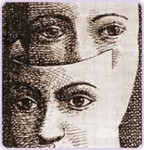 I write about deception not to train the reader in its arcane arts, but to research my novels. There is deception in nearly any situation you can think of––nature, business, politics, or personal relationships––anywhere it might provide someone, or something, an edge.
I write about deception not to train the reader in its arcane arts, but to research my novels. There is deception in nearly any situation you can think of––nature, business, politics, or personal relationships––anywhere it might provide someone, or something, an edge.
The craggy-faced, white-haired gentleman extends his hands self-deprecatingly. “I’m just a simple country lawyer…” he says. You cover your wallet with your hand.
The general and his wife, honored guests at the baptism, congratulate the captain on the birth of his first child, a son. The captain beams over the guests, so proud, just so proud. His wife frets over the loaded table. The general’s teen-age son lolls against the door.
A young woman, her complexion clear and eyes blue, is seated on the divan holding the child, cooing. A blue pendant hangs where neckline of her white blouse and the lift of white skin meet. “Isn’t he beautiful,” she says, holding the child swathed in a knitted white baptismal blanket.
The son gazes at the pendant. The general’s wife, greying, wearing striped suit jacket with skirt, looks on. ‘If that boy thinks he’s coming within twenty miles of this female, I swear I’ll break his leg. Trouble. She’s trouble.’ “Yes, dearie,” she says to the child’s mother, touching her wrist, “You do set a beautiful table.”
CHANGE WE CAN BELIEVE IN!!!!
The Black Book of Communism[1] counted the contents of the 20th century’s mass graves and judged this great hope of humanity a cruel deception.
The Black Book of Capitalism[2] counted the contents of 19th-20th centuries’ mass graves to blame rapacious economic exploitation.
We deceive. We are deceived. We learn, sooner or later or never.
To keep body and soul together, we seek food, shelter, and love. We sense and interpret reality, which is distorted, naturally or with purpose. Deception & counter-deception––two sides of the same coin.
What do we mean by deception?
Words deceive us. When we study deception, we find there are theories, structures, principles, frameworks, taxonomies, and typologies, all of which attempt to explain deception. All are similar and yet different. A plethora of terms such as camouflage, dazzling, disinformation, masking, and mimicking, as well as decoys, diversions and ruses are used to describe deception techniques, methods, and effects…
in English. There is an extensive formal and informal Russian vocabulary that spins deception differently.
…likewise Chinese, which has had a formalized, written deception taxonomy since at least Sun Tszu. And so on.
Our understanding of deception is clouded as commentators spew out clouds of words.
Can we make it simpler?
Probably not, but…
Barton Whaley in his book Stratagem:Deception and Surprise in War[3] introduces what will become the generally accepted model of deception in nearly all of the strategic deception literature that follows: the concepts of Cover-and-deception or dissimulation and simulation. Dissimulation is the concealment of truth and simulation is the presentation of that which is false. Whaley notes that some combination of both is present in most, if not all, of the great historical stratagems. They reinforce each other to that their effect in combination is greater than the effect of either one used alone. In addition, the ineffectiveness of one can be compensated for by the effectiveness of the other (e.g., a good deception operation can compensate for compromises in cover and security).
I will use the generally accepted current term for this art––denial and deception. All other words are sub-orders of the taxonomy.
How does one do a deception that succeeds? Again, I am (re) teaching myself.Let’s look at some deception maxims [4], ‘rules of thumb’, heuristics as it were, despite the warnings of researchers in human cognition.
| Maxim 1: Magruder’s Principle | It is easier for the target to maintain a preexisting belief even if presented with information that would be expected to change that belief. |
| Maxim 2: Limitations to human information processing | Several limitations to human information processing can be exploited in the design of deception schemes, including the law of small numbers and the susceptibility to conditioning. |
| Maxim 3:The Multiple forms of surprise | Surprise can be achieved in different forms: location, strength, intention, style, and timing |
| Maxim 4: Jones’ Lemma | Deception becomes more difficult as the number of channels available to target increases. Nevertheless, within limits, the greater the number of channels that are controlled by the deceiver, the greater the likelihood that the deception will be believed. |
| Maxim 5: A choice among types of deception. | Where possible the objective of the deception planner should be to reduce the ambiguity in the mind of the target in order to make the target more certain of a particular falsehood rather than less certain of the truth. |
| Maxim 6: Axelrod’s contribution: The husbanding of assets | There are circumstances where deception assets should be husbanded, despite the costs of maintaining them and the risk of exposure, until them can be put to more fruitful use. |
| Maxim 7: A sequencing rule | Deception activities should occur in a sequence that prolongs the target’s false perceptions of the situation for as long as possible. |
| Maxim 8: The importance of feedback | Accurate feedback from the target increases the deception’s likelihood of success |
| Maxim 9: The Monkey’s Paw | The deception may produce subtle and unwanted side effects. Deception planners should be sensitive to this possibility and attempt to minimize them |
| Maxim 10: Care in the design of planned placement of the deceptive material | Great care must be taken when designing schemes to leak notional plans. Apparent windfalls are subject to close scrutiny and are often disbelieved. |
[1] {{200 Courtois,Stéphane 1999;}}
[2]{{317 Suret-Canale,Jean 1998;}}
[3]{{326 Whaley,Barton 2007;1969;}}
[4] {{327 Deception Maxims: Facts and Folklore 1980;}} http://books.google.com/books/about/Deception_maxims_fact_and_folklore.html?id=hntoHAAACAAJ
I am having trouble getting Refworks to expand. I’ll fix it soon.









